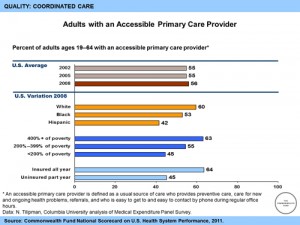 It was Dr. Charles Safran who said, “Patients are the most under-utilized resource in the U.S. health system,” which he testified to Congress in 2004. Seven years later, patients are still under-utilized, not just in the U.S. but around the world.
It was Dr. Charles Safran who said, “Patients are the most under-utilized resource in the U.S. health system,” which he testified to Congress in 2004. Seven years later, patients are still under-utilized, not just in the U.S. but around the world.
Yet, “when patients have an active role in their own health care, the quality of their care, and of their care experience improves,” assert researchers from The Commonwealth Fund in their analysis of 2011 global health consumer survey data published in the April/June 2010 issue of the Journal of Ambulatory Care Management. This analysis is summarized in International Perspectives on Patient Engagement: Results from the 2011 Commonwealth Fund Survey, published on The Commonwealth Fund’s website on March 29, 2012.
Hallmarks of patient engagement include shared decision making and health self-management of chronic conditions, which are penetrating health systems the world over. In the 11 countries The Commonwealth Fund surveyed in 2011, patient engagement levels vary across countries.
In seven of 11 countries, patients with below-average incomes were significantly less likely to have been engaged by their regular doctor in their care. These lower-performing nations include Australia, Canada, the Netherlands, Norway, Sweden, the United Kingdom and the U.S. While America is in dubious “good” company with these other nations, the U.S. stood out for the widest income-based disparities.
In all countries, patients say the positive communication and engagement with their regular doctor (read: medical home) were more likely to rate the quality of care they receive as excellent or very good. The difference between highly-rated care by patients and lower-rated care is greatest in the U.S., where 78% of patients who said they were engaged in their care rated their care highly, compared with 43% who were not so engaged.
Health Populi’s Hot Points: Engaged patients were less likely to report a medical, medication or lap test error in the past two years, and felt more positively about their health systems than un-engaged patients.
The highest performing health systems based on patient engagement were Switzerland and the U.K. Even though they finance and deliver care quite differently, with Switzerland having a more medical insurance market approach than single-payer U.K., both use the medical home concept where every health citizen is covered first by a primary care provider. These PCMHs act as referral agents for all aspects of care, ensuring continuity of care when referred to specialists, tests, and other services as required.
Health reform, the Affordable Care Act, is being debated by the Supreme Court this week. I hope the inclusion of medical homes and primary care expansion isn’t the proverbial baby that could be thrown out with the bath water by the Supremes who may choose to diss the law in its entirety. Without primary care medical homes, the U.S. has no hope of bending the cost curve or improving quality on par with the rest of the developed world.




 Interviewed live on BNN Bloomberg (Canada) on the market for GLP-1 drugs for weight loss and their impact on both the health care system and consumer goods and services -- notably, food, nutrition, retail health, gyms, and other sectors.
Interviewed live on BNN Bloomberg (Canada) on the market for GLP-1 drugs for weight loss and their impact on both the health care system and consumer goods and services -- notably, food, nutrition, retail health, gyms, and other sectors. Thank you, Feedspot, for
Thank you, Feedspot, for  As you may know, I have been splitting work- and living-time between the U.S. and the E.U., most recently living in and working from Brussels. In the month of September 2024, I'll be splitting time between London and other parts of the U.K., and Italy where I'll be working with clients on consumer health, self-care and home care focused on food-as-medicine, digital health, business and scenario planning for the future...
As you may know, I have been splitting work- and living-time between the U.S. and the E.U., most recently living in and working from Brussels. In the month of September 2024, I'll be splitting time between London and other parts of the U.K., and Italy where I'll be working with clients on consumer health, self-care and home care focused on food-as-medicine, digital health, business and scenario planning for the future...